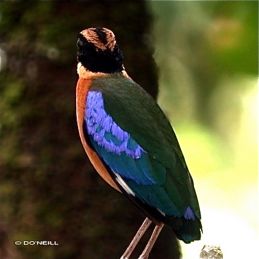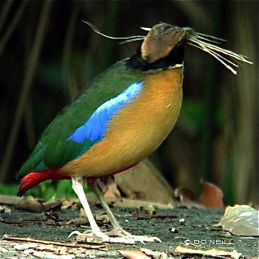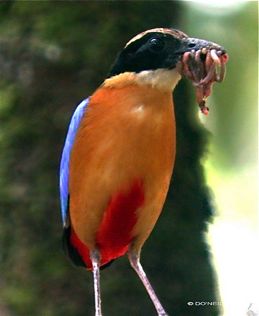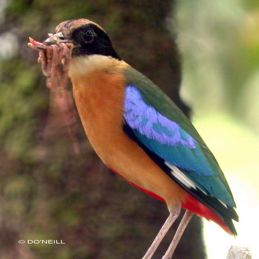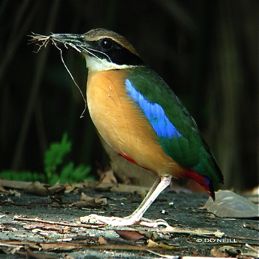There is no other better way to launch the second phase of writing for BESG than by contributing the 61st article signature bird family – ‘Pittidae’ for readers to enjoy a comparison in bird digiscopic photography.
With only five species represented in Peninsular Malaysia, each with low count population, fewer still their known habitats, these colourful, ground dwelling creatures are much besotted by birders and photographers for looks and keep sake.
Let’s zoom in on two species that look quite alike at first glance and try making a comparison to distinguish genetic differences in their appearance.
Let’s see if these elusive birds can stump birders and B-photographers who think they know the Blue-winged Pitta (Pitta moluccensis) and its cousin- Mangrove Pitta (Pitta megarhyncha) well.
In doing so, let’s hope to learn and appreciate their scarcity, value their species’ presence, conserve their habitats in our tropical rainforests and give them the space and all opportunities to breed without unnecessary human interference and stress.
Let the Blue-winged Pitta be called Mo and the Mangrove Pitta, Mighty. By pairing Mo and Mighty, let us begin with Plate 1 (below left) and 2 (below right) to compare their rear views. (All odd Plate numbers are Mo, all even Plate numbers are Mighty).
Mo wears a light brown cap shaped like rugby ball drawn with a medial long, black stripe. Mighty’s cap is a bit wider and tainted with haphazardly splashed, faint and blackish patches. (The latter may be absent in other birds of same species.)
Both wear black eye-bands. Mo’s eyes band is thick and remains circumventing to behind the neck or nape as it is called; whereas the rear band of Mighty appears much narrower at the nape. Plate 3 (below left) and 4 (below right) show the front view.
Notice that Mo’s beak is bulky and bulging on the upper mandible and the length is about at most, two-third’s the horizontal to the length of its head (from gape to nape).
How about Mighty? His plumage conveys his gender and seems to be carrying nesting material steadily with a slimmer, longer beak the full length close to same as the head.
The black eye-band of Mo rides high over the upper eyelids whereas Mighty’s demarcation line of its eye-band is limited to the edge of the upper eyelids bordered by a faint, whitish eye brow or supercillium.
Let’s take a look at their bellies. Mo’s appear to be more conspicuous with a larger area of red plumage beginning from the vent (area of under body behind feet of the bird), spreading passed between the legs and over the belly and ending about midway between throat and vent of the bird. The extent of Mighty’s red belly appears to be much lower.
Plate 5 (below left) and 6 (below right) show the side view.
The prima facie of Mo has to be the blue wings for which the bird is named. The anatomical details of feathered wing parts are well represented here. In perched position the black primary margins with white wing bar is seen. Sometimes, they are partially hidden pending the way the bird folds its wings.
Images of the Mangrove Pittas’ shown here in perched or stand position show no marginal black, primaries with white wing bar. The white- winged patches are present but smaller and are concealed. Only in minority of exceptional images or reasons whatsoever are they partially seen or not seen.
Through the good office of Bruce Ramsay’s research on all available images found in websites, only two exceptional images showed white wing bar on perched/stand position.
Field researchers and ornithologists’ who handle birds would be able to document in more detail, the exact number of primary feathers splashed with white.
The above observations are noted based on the respective images taken in the field with some pointers not mentioned in various bird field guides.
Plate 7 (left) is posted raw in its original form with no photo -shopping done. It is a sample to show that images of birds in photography, when enhanced by photo-shopping skills and in the hands of expert make- up artists do bring the best out of the birds, hopefully to be as natural as possible and to show finer aspects of birds’ plumages and anatomical details not easily seen in the field.
It is not difficult to confirm that lighting plays tricks on photography. Therefore, I have not deliberated on the differences in plumage colours of the pittas- they may be misleading or inaccurate.
Hues of feathers change under different lighting conditions and under different angle of light rays. Colours will appear toned down under dark conditions and tinted up under bright conditions respectively. Iridescence is lost in dark or bad lighting situations where light rays cannot penetrate or hit at the right angle. Dark blue, or brown tones appears black and in bright light, tints of colour white, cream, light yellow, buff, beige are simply glaringly white and misleading.
Added with advancement in computer technology, it is possible with a click of a mouse, to transform colours of bird images to one’s fancy.
In the hands of a sorcerer’s apprentice it is possible to paint a red pol-ka dot pitta and much more!
A bird specialist with a discerning eye who knows his/her pittas well will be looking out for more markers for another comparison or two not mentioned.
Only one picture plate gives it away and Mo would like to pick the brains of the uninitiated….
The clue…..?
Ask Wriggly!
AVIAN WRITER DAISY O’NEILL PENANG MALAYSIA
© BLUE-WINGED PITTA VS MANGROVE PITTA


